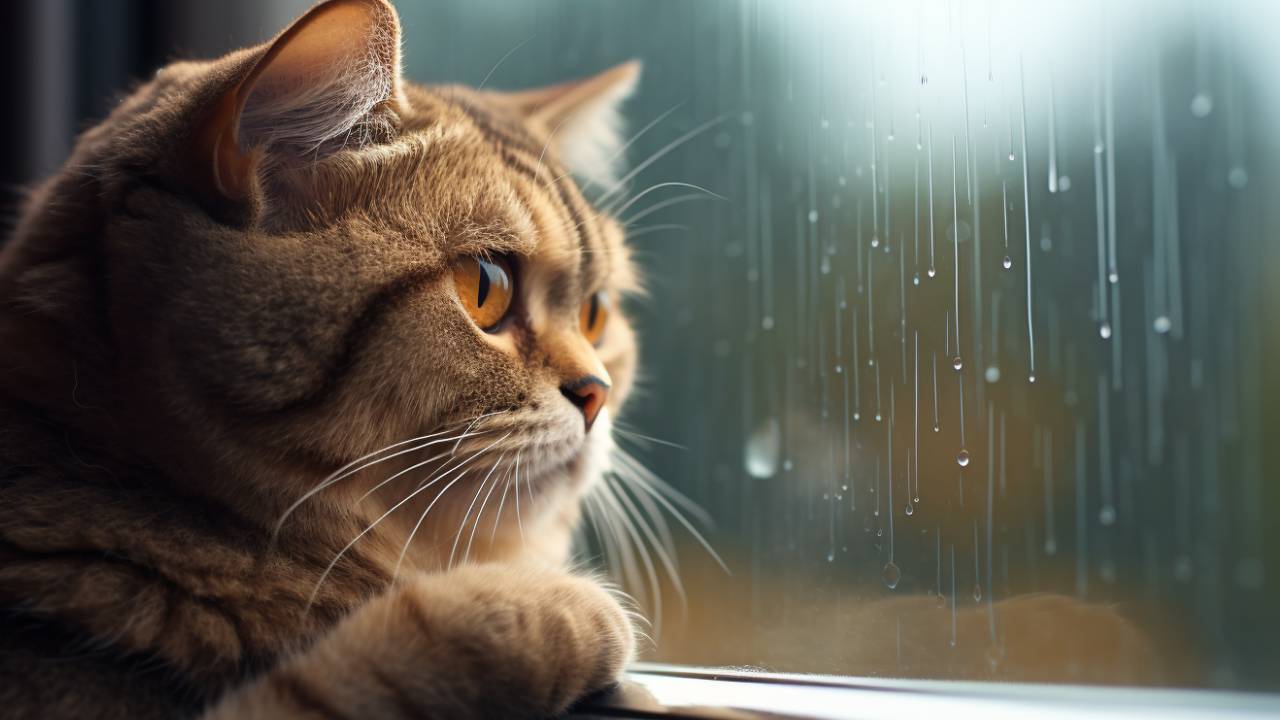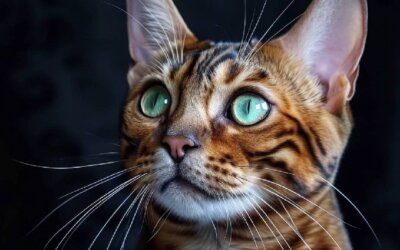In the fascinating realm of our feline friends, their complex behaviors and expressions often draw us into a world of mystery. Among the many questions that spark curiosity in the hearts of cat enthusiasts is the intriguing notion of feline tears. Let’s find an answer: can сats сry tears of sorrow?
The Reasons A Cat Can Have Watery Eyes
With their mysterious allure and expressive natures, cats sometimes display watery eyes, leading us to wonder about the emotions behind those glistening gazes. Yet, we can better care for these enigmatic creatures by understanding why cats may exhibit this condition and ensure their well-being.
Environmental Triggers for Watery Eyes in Cats
Like us, cats can become irritated by environmental irritants such as dust, pollen, and airborne particles. When these irritants contact a cat’s sensitive eyes, they prompt an increased production of tears. This natural response aims to flush out the irritants, safeguarding the cat’s vision and keeping their eyes clear.
Notice your cat’s eyes getting watery after a romp outside or in particularly dusty areas? It’s their body’s way of coping with these pesky invaders.
The Role of Breed Characteristics in Cat Eye Health
It’s fascinating how genetics play a role in the health of our pets, particularly in certain cat breeds like Persians and Himalayas. These breeds, known for their distinct flat-faced (brachycephalic) features, often have unique anatomical structures, including shorter nasal passages and tear ducts positioned differently than their long-faced counterparts.
This can lead to tears gathering more readily in the corners of their eyes, sometimes causing overflow and the characteristic staining seen around the eyes of these breeds. For flat-faced feline breeds, consistent eye cleaning and vigilant care are essential to prevent discomfort and stave off potential infections, ensuring these beautiful cats remain happy and healthy.
Infections and Allergies Affecting Cat Eyes
Like other living beings, cats are not immune to infections and allergies, which can significantly affect their eye health. Conjunctivitis, an inflammation of the eye’s outer membrane, is a common ailment with symptoms such as redness, swelling, and an uptick in tear production, which can cause watery eyes.
Similarly, allergic reactions to environmental elements like pollen, dust mites, or certain foods can cause comparable symptoms. Pinpointing the exact cause behind these watery eyes is critical, as the appropriate treatment will vary—ranging from medication to manage an infection to lifestyle adjustments to mitigate allergy triggers.
The Concern of Corneal Ulcers in Cats
Another less common but significant condition leading to watery eyes in cats is the development of corneal ulcers. These are essentially small wounds on the eye’s surface, typically the result of trauma or the presence of foreign objects. Corneal ulcers can be painful and increase tear production as the body tries to soothe and heal the affected area.
Prompt veterinary care is paramount if a corneal ulcer is suspected to avoid further complications and ensure your cherished pet’s speedy recovery. Recognizing and understanding the myriad causes behind watery eyes in cats is a key component of their care, reinforcing the deep bond shared between cats and their caretakers.
The Science Behind Cat Tears
The phenomenon of cats “crying” is often misunderstood, leading us to project human emotions onto our feline companions. However, the reality of why cats have watery eyes is rooted in physiology rather than emotion. Here’s a breakdown that combines both explanatory text and bullet points for clarity:
Cats have a sophisticated ocular system with tear glands and ducts like humans. This system is primarily designed for eye health maintenance rather than emotional expression. The reasons behind tear production in cats include:
- Lubrication: Tears moisten the eye’s surface, preventing dryness and irritation.
- Protection: Tears help remove irritants and debris from the eyes as a defense mechanism.
Unlike humans, cats do not use tears to express many emotions. Their communication strategies are vastly different, relying on:
- Body Language: Tail flicks, ear positions, and body postures convey much of a cat’s feelings.
- Vocalizations: Cats use various sounds to express their needs and emotions, from purrs to meows.
- Behavioral Cues: Activity levels, eating habits, and interaction changes can indicate a cat’s emotional state.
When a cat’s eyes appear watery, it’s crucial to understand that this might not reflect their emotional well-being but could indicate health concerns. Factors contributing to increased tear production in cats include:
- Environmental Irritants: Dust and pollen can cause the eyes to water in an attempt to clear these substances.
- Health Conditions: Eye infections, allergies, or other underlying health issues can also lead to watery eyes.
Understanding the real reasons behind a cat’s watery eyes helps us provide better care and respond more appropriately to their needs, reinforcing the bond between cats and their human companions.

Other Reasons Why Cats Cry
Cats communicate in various ways, and not all forms of “crying” involve tears. Here are some other reasons cats may “cry,” showcasing their diverse vocal communication:
- Caterwauling During Heat: Female cats have a specific cry called caterwauling, which is distinct from other vocalizations. This sound signals their availability to male cats and plays a crucial role in mating. Although it doesn’t involve actual tears, caterwauling is a potent form of communication about their reproductive state.
Read more about caterwauling, a specific vocal behavior unique to cats.
- Expressions of Discomfort or Pain: Cats also vocalize when they’re in pain, uncomfortable, or unwell, similar to how humans might groan or cry out when hurt. These vocal expressions can vary in sound and intensity but are generally a cat’s way of signaling something is wrong, possibly pointing to a health issue requiring immediate attention.
Understanding these vocal cues is essential for cat owners. They offer valuable insights into the well-being and needs of their feline friends, ensuring that they receive the care and attention they deserve.
Conclusion
Cats don’t cry tears of emotion like humans, but they can have watery eyes due to various factors such as irritants, infections, or breed-specific traits. Understanding your cat’s behavior and recognizing the reasons behind their watery eyes can help you provide appropriate care.
Even though cats may not cry as we do, they still have unique ways of expressing their needs and emotions.

FAQs
Can cats cry tears of sadness?
No, cats can’t cry emotional tears like humans. Their tears primarily serve the physiological purpose of maintaining eye health.
How can I stop my cat from yowling excessively?
To curb excessive yowling, first, ensure your cat’s basic needs, such as food, water, and a clean litter box, are met. If the yowling persists, consult a veterinarian to rule out any underlying health issues.
Do cats cry for attention?
Cats might cry to seek attention, especially if they’re in pain or discomfort or need companionship.
What’s the difference between caterwauling and crying?
Caterwauling is a vocalization primarily associated with female cats in heat. It signals reproductive readiness and is distinct from crying.
How can I tell if my cat is sad?
Changes in behavior, such as lethargy, loss of appetite, and isolation, can indicate that your cat might be experiencing sadness or underlying health issues. It is recommended that you consult a vet.






Always wondered if cats could cry. Your article was eye-opening! Have you ever seen your cat shed tears, or is it just a myth? 😿💧